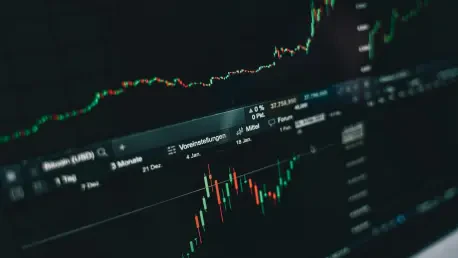Market Snapshot: Unpacking the Oil Price Decline
In a striking turn of events, oil prices have stumbled, with Brent crude futures dipping by 0.5% to $65.62 per barrel and U.S. West Texas Intermediate (WTI) crude futures easing by 0.3% to $61.31 per barrel, raising pressing questions about the stability of global energy markets. At a time when supply decisions and geopolitical undercurrents are colliding, this decline demands a closer look. The catalyst behind this shift is OPEC+’s strategic plan to increase production in December, a move that could reshape market dynamics. This analysis aims to dissect the forces at play, offering a clear lens on why prices are faltering and what lies ahead for stakeholders. By delving into current trends and future projections, the goal is to equip industry players with actionable insights to navigate this volatile terrain.
Deep Dive: Analyzing Oil Market Trends and Projections
OPEC+’s Strategic Shift: Boosting Supply for Market Share
At the core of the current price dip is OPEC+’s decision to ramp up output in December, spearheaded by eight key members, including Saudi Arabia. This calculated increase, aimed at reclaiming market share, marks a pivot from earlier production cuts designed to prop up prices during periods of oversupply. The move introduces a surplus risk in a market already grappling with uneven demand, potentially driving prices lower if consumption fails to match the added supply. Analysts caution that while this strategy may bolster OPEC+’s competitive edge, it could backfire without synchronized global economic growth.
The internal dynamics within OPEC+ further complicate this scenario. For instance, Iraq, a significant producer, is negotiating its quota of 5.5 million barrels per day amid challenges like overproduction that test the coalition’s unity. Despite localized disruptions, such as a recent fire at the Zubair oilfield, exports remain unaffected, underscoring the resilience of supply chains. This balance between increased output and internal cohesion remains a critical factor to watch as December approaches.
Geopolitical Ripples: Trade Deals and Sanctions in Focus
Beyond supply adjustments, geopolitical forces are injecting uncertainty into oil price trajectories. A high-stakes meeting between U.S. and Chinese leaders looms large, with the potential to forge a trade deal framework that might avert punitive tariffs and export restrictions on rare-earth materials. Remarks from U.S. Treasury officials about progress toward a substantial agreement have tempered some market fears, yet skepticism persists until tangible results emerge. A resolution here could stimulate economic activity and, by extension, oil demand, offering a counterweight to OPEC+’s supply push.
Simultaneously, renewed U.S. sanctions on Russian oil entities, alongside parallel measures from the European Union, pose a wildcard. If enforced rigorously, these restrictions could constrict supply and provide upward pressure on prices, offsetting OPEC+’s output hike. However, the effectiveness of these sanctions hinges on unclear enforcement mechanisms, leaving market participants wary of banking on immediate impacts. This geopolitical tug-of-war adds a layer of complexity to forecasting price movements in the near term.
Demand Dynamics: Global and Regional Variations
Demand trends paint a mixed picture, contributing to the oil market’s fragility. Brent crude recently hit its lowest mark since May, reflecting sluggish global consumption that continues to weigh on sentiment. A sustained recovery in U.S. demand is seen as pivotal to stabilizing prices, particularly after last week’s notable gains—Brent surged 8.9% and WTI climbed 7.7%—partly fueled by stronger American consumption figures. Without consistent demand growth in key markets, the risk of further price erosion looms large.
Regionally, disparities add nuance to the outlook. Iraq’s overproduction within OPEC+ highlights compliance challenges, while potential supply tightness from Russian sanctions could affect specific markets. Misunderstandings about demand often amplify short-term volatility, but the underlying reality is that long-term price recovery depends on economic momentum in major consuming regions. These demand-side factors, intertwined with supply and geopolitical variables, create a multifaceted challenge for market stability.
Future Outlook: Emerging Patterns and Predictions
Looking forward, several trends suggest potential shifts in the oil landscape. OPEC+’s emphasis on volume over price support may herald a prolonged strategy of market share prioritization, reshaping competition with non-OPEC producers. Technological innovations in extraction and the rise of renewable energy could gradually alter supply-demand balances, potentially reducing reliance on traditional oil over time. Regulatory pressures, such as stricter emissions standards in major economies, might also curb consumption, adding downward pressure on prices.
Projections hinge on key variables, including the outcome of U.S.-China trade talks, which could spur demand if resolved favorably. Conversely, persistent geopolitical risks, like uneven sanctions enforcement, remain unpredictable. Market analysts anticipate that from this year to 2027, the interplay of economic growth, policy shifts, and technological advancements will redefine oil market fundamentals. Adaptability to these evolving forces will be essential for industry players aiming to stay ahead of the curve.
Reflections and Strategic Pathways
Reflecting on the insights unearthed, it becomes evident that OPEC+’s planned output increase has driven short-term price declines, while geopolitical developments and demand recovery shape longer-term uncertainties. The analysis highlights how intertwined factors—from trade negotiations to sanctions on Russia—have created a volatile environment for oil markets. Each element, whether supply strategy or external policy, plays a distinct role in the price narrative.
For businesses and investors, the path forward involves proactive risk management through tools like futures contracts to hedge against price swings. Monitoring pivotal events, such as trade deal outcomes, proves crucial for timely decision-making. Energy sector stakeholders also need to explore diversification into alternative energy investments to buffer against oil-specific volatilities. By staying attuned to global economic indicators and policy shifts, industry participants can better position themselves to capitalize on emerging opportunities in this ever-shifting market landscape.









